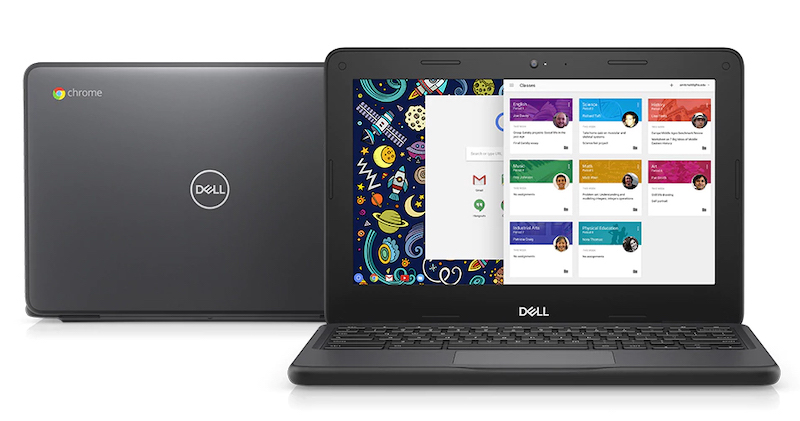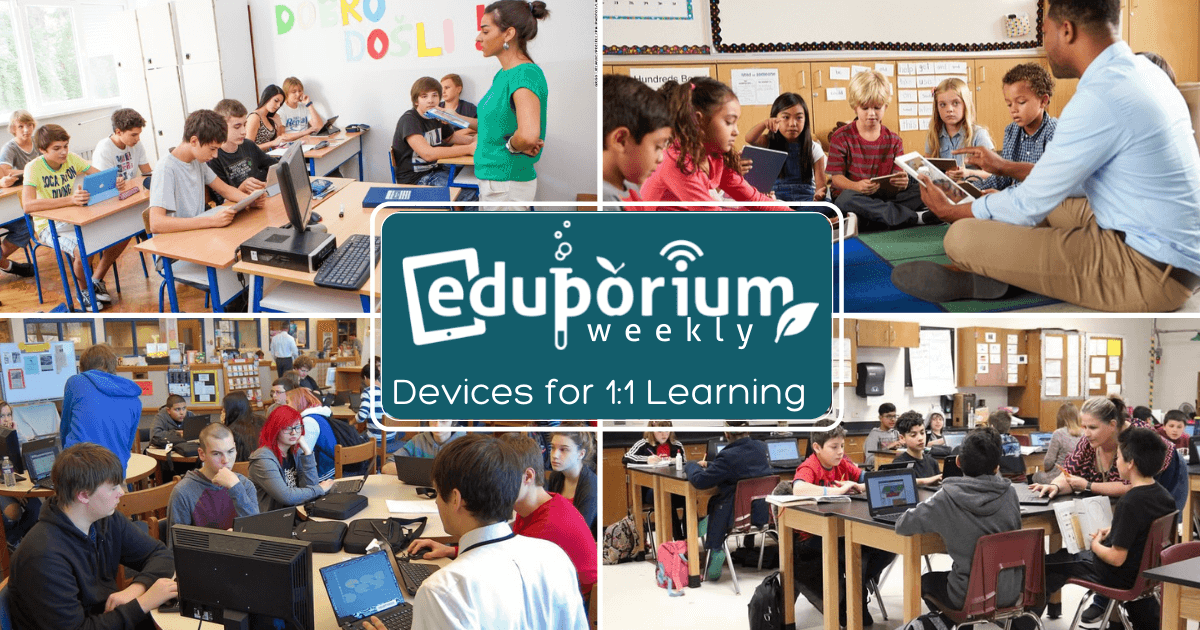If you’re thinking about going 1:1 in your school or district, there are a lot of things to consider. The first among them is the goals you hope to achieve with this initiative and then you’ll probably get into considering which computers to use. A 1:1 program offers students a nice advantage when it comes to accessing information, but there are other things for school leaders to consider, such as cost. If you’re still determined to make it work, here are some of the best models for achieving a successful 1:1 rollout.
HP Chromebooks
HP is, of course, one of the most significant names in computing and, like so many others, they, too, have made the leap into the education space. Almost every computer company has come up with their own version of the Chromebook due to its wide-scale approval among educators. Even after you narrow it down to Chromebooks, there are still a number of options school leaders could choose from with just HP alone. Of course, some are better than others and some will work better in certain 1:1 programs than others will. The bottom line is that what works perfectly in one classroom may not be the right model for a different 1:1 classroom.
To get started, we’ll first recommend the classic HP Chromebook. We know that the first thing teachers and tech purchasers tend to look at is the price of the computer. This particular model comes in at around $200, although we could likely get a bit of a discount on that for schools who are interested in ordering in bulk. Performance wise, the HP Chromebook elevates classroom engagement and helps inspire learning through a number of collaborative challenges. It uses the Chrome OS, which offers both teachers and students a highly simplified platform for managing their work and a highly reliable system for accomplishing more. Plus, it has enough power, memory, and storage for kids to be able to use them all year without the fear of it breaking down.
Another good HP model is the HP Stream, which runs Windows and allows students to take their learning anywhere they would like. This computer is designed for students who are hard working and leverage their laptop to get more accomplished each and every day. The battery seemingly lasts forever and includes 100 GB of free storage. Plus, students get access to more memory than they would ever need, crystal-clear graphics to help bring lessons to life, a completely secured network, and a whole lot more. Like the classic Chromebook, the HP Stream comes in at just over $200, making it a strong consideration for helping create successful 1:1 programs!
Lenovo N42
Sure, most tech companies are getting into the compact and affordable device space. Why wouldn’t they be? So much of education is shifting toward tech-based instruction and they are definitely aware of this market. It’s kind of difficult, though, to make a machines that’s reliable, affordable, and safe for students. Some of the industry’s giants, of course, have done their part to help make this happen and the geniuses at Lenovo are no exception. In our office, Lenovo laptops are a crowd favorite because of their small size, light weight, and efficiency. Not to spoil the rest of the post, but they have the same exact benefits in the classroom as well and there are plenty of them that are completely affordable.
When recommending devices for 1:1 programs in schools, we tend to suggest the most affordable ones first since most of them are looking to purchase in bulk. They also make use of our Request a Quote feature so that they know we’re getting them the best possible price. Anyway, when it comes to Lenovo, among the most affordable laptops that we carry is the Bluetooth-friendly N-42. This compact champ includes an Intel Celeron Processor, 4GB of RAM, HD graphics, and the Chrome operating system. See, just because it’s not made by Google doesn’t mean it doesn’t sound like a Chromebook you’d like to try, right?
The N42 is light, portable, rugged, and reliable since it’s built simply to maximize classroom productivity and enhance performance. Plus, it’s extremely easy to manage and very simple for students to share whatever they need, whether that’s turning in assignments or pulling something up to work on collaboratively. Its most classroom-friendly feature might be that it’s ready to use right out of the box. Neither teachers nor students need to waste time or effort installing any complicated programs or getting it set up themselves. The Chrome OS is ready to use as soon as they power it on! Students just need a Google account and they’re ready to start using this affordable Chromebook to advance their learning!

DELL Does Chromebooks, Too
Okay, so maybe there’s a theme developing here. For the third straight time, one of our 1:1 device recommendations is a Chromebook—this time from DELL. As we said, all the big players are trying to break into the education space and DELL has an affordable option of their own. Besides its reasonable $212.26 price point, DELL's Chromebook 3180 comes with a number of features that provide students with a smooth classroom experience, including an Intel Celeron processor, 16GB eMMc, its own WLAN, Bluetooth capabilities, a webcam, and Chrome OS. We realize that these features are fairly similar to other 1:1 devices, but, at this price, they’re pretty hard to pass up.
Unlike some of the other laptops that would work well in 1:1 programs, this Chromebook is actually designed specifically to enrich education. It’s great at empowering students to take control of their learning, too, thanks to its ability to help facilitate collaborative experiences and easy sharing among groups of students. And, that’s just the start of its classroom-friendly features. The 3180 comes with a guaranteed 10 hours of battery life, ensuring that it lasts the entire school day without needing to be charged. It also includes a spill-resistant seal and rubberized edges to guard against students who tend to spill the drinks they must have or drop stuff on the ground. And, hey, who doesn’t love that?
One of the best features of this Chromebook is that a number of them can fit easily into a separate charging cart. And, in that cart, they can all be charged overnight or over the weekend using just one simple device. Then, you have the software. The 3180 features the full G Suite, which has been evolved to fit the machine and advance modern education. It includes all the relevant Google Apps for Education that students could possibly need for any of their subjects and helps easily integrate Google Classroom for teachers and parents, too! This is pretty cool, too: this particular model includes a learning light, which silently lets teachers know if a student is finished with their work or has a question they need help answering. So, all in all, there is a lot to like about the DELL Chromebook 3180.
Trying Tablets As Well
If you have a 1:1 program in your school or district, you do not necessarily have to be completely tethered to using laptops as your devices. Tablets are almost as popular as using laptops in the classroom and offer some different benefits as well as some of the same ones. Tablets allow for greater mobility as students are able to pick them up and bring them to different parts of the school more easily. They tend to charge a bit faster as well and, chances are, most kids already know how to use them—especially if you go with iPads, which a lot of schools have done in the past and continue to do now. The wide availability of specialized apps also helps make tablets much more relevant in the classroom and cements their status as legitimate teaching tools.
Much like Chromebooks, many of the nation’s leading tech companies have developed tablets of their own. While these tablets are not necessarily designed for education, they can still help advance learning in just about any classroom. Some of the big names to produce affordable and classroom-friendly tablets include DELL, Lenovo, and Samsung. Samsung’s signature tablet is, of course, the Galaxy Tab, which is very popular among consumers. It can be just as effective in the classroom, though. The Galaxy offers great speed and reliability and is designed to help facilitate innovation without a large learning curve. And, depending on which model you choose, they can be as cheap as $200 or $250, too.
When it comes to leveraging tablets in 1:1 classrooms, certain features are more beneficial for learning than others. We touched on the quick-charge ability, but it’s also important to consider if the tablets can be used while they are charging. Sometimes, this tends to drain the battery faster than it is replenished and might not be a good option for students who are going to be using them throughout the day. Classroom tablets should also include cases and screen protectors because we all know how easily they can crack. Other than that, just try to go with anything that’s fast, efficient, and doesn’t require constant, device-altering updates every week or two!

Other Ways to Go 1:1
While writing this, we came to the realization that 1:1 programs don't always have to mean every student has a device. It basically just means that every student is equated as long as they all have access to something that boosts their learning—whether that’s a computer, tablet, or something else. It depends what class they are in, but there are other ways to incorporate technology and innovation while still creating an environment conducive to that specific subject. For example, would a tablet really be that beneficial to every student in a math class? Sure, they can probably find a few useful apps to help them with certain concepts and take advantage of the built-in calculator to maximize their efficiency. What else would a tablet really be good for in a math class, though?
The answer to that is, unfortunately, not all that much. Particularly in a math class, a 1:1 solution that would seem to benefit students the most is the implementation of graphing calculators. At least when I was in school, they were widely used and helped students to really be able to visualize all the complex mathematical problems they were expected to solve. That’s not to say that laptops and tablets are useless; it’s just that they’re not as helpful in a math class as they would be in different classrooms. Plus, many graphing calculators are more affordable generally than buying a tablet or a laptop—especially when purchasing one for every student in the class.
Besides math classes, other STEM subjects require students to use different technology tools to create the best learning experience possible. Sometime, these include computers and tablets, and, other times, they do not. In a Biology class, for example, students could each have their own microscope (theoretically), set of tools, or something else (sorry, it’s been a long time since I took Biology). The concept remains the same in that as long as they have constant access to beneficial tools, their learning will improve. Creating 1:1 programs is not all about the newest laptop or coolest tablet. There are other ways that teachers can get creative and engage students more effectively by developing a unique 1:1 plan.
For the latest EdTech, STEM, and 21st century education news, follow us on Twitter and Instagram. Like us on Facebook, too, or sign up for our newsletter for our latest product announcements and offerings. If you have an idea for an Eduporium Weekly theme, send us a message on social media or comment below.



